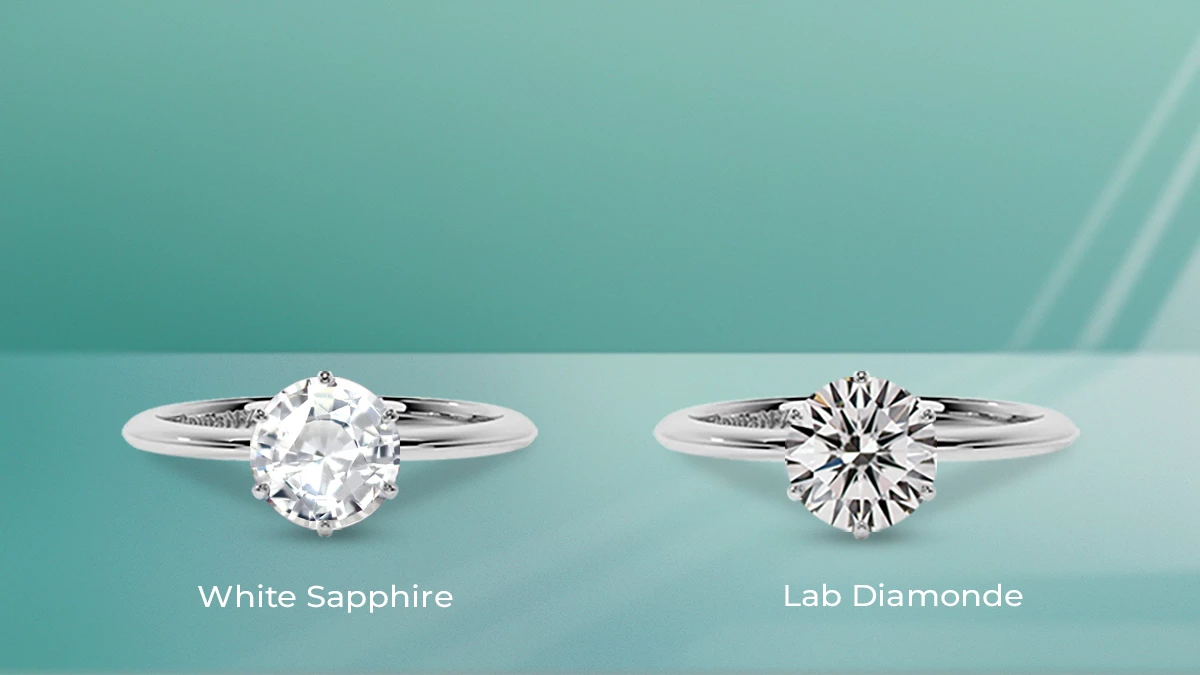
When it comes to choosing between gemstones for an engagement ring or other fine jewelry, many consumers often find themselves deciding between white sapphires and diamonds. Both stones share a similar appearance but differ in several key areas, including their durability, price, and overall look. As more people explore the possibilities of lab-created diamonds, understanding the differences between white sapphire vs diamond. This article explores the unique characteristics of both stones, with a focus on lab-created diamonds.
White Sapphire vs Diamond: The Basics
White sapphires and diamonds are both popular choices for engagement rings and other fine jewelry, thanks to their elegant and timeless appeal. White sapphires are a variety of corundum, and while they lack the fiery brilliance of diamonds, they still offer a striking visual presence. On the other hand, diamonds are renowned for their unparalleled brilliance and are one of the hardest natural materials known to man. Lab-created diamonds, which are engineered to replicate the qualities of natural diamonds, have also gained popularity for their eco-friendly and ethical appeal.
In terms of appearance, both white sapphires and diamonds are clear and colorless, making them visually similar at first glance. However, the way each stone reacts to light and its overall brilliance sets them apart. Lab-created diamonds, in particular, replicate the sparkle of natural diamonds, thanks to their cut, clarity, and the way they interact with light.
Durability and Hardness: Comparing White Sapphire and Diamond
One of the most important factors to consider when choosing between white sapphire and diamond is the durability and hardness of the stones. Diamonds are the hardest known substance on the Mohs scale of hardness, scoring a perfect 10. This makes them incredibly resistant to scratching and ideal for everyday wear. Lab-created diamonds, which are chemically and physically identical to natural diamonds, share this remarkable hardness, ensuring they maintain their beauty over time.
White sapphires, while still relatively hard, fall short of diamonds in terms of durability. Scoring 9 on the Mohs scale, they are still resistant to scratches but can be more prone to damage over time, especially if not properly cared for. For those looking for a stone that will endure a lifetime of daily wear, lab-created diamonds are an excellent option, providing the same level of durability as natural diamonds.
White Sapphire vs Diamond: Price Considerations
Price is often one of the most significant factors when comparing white sapphires and diamonds. Generally, white sapphires are much more affordable than diamonds. The lower price point of white sapphires makes them a popular choice for those who desire the look of a diamond without the hefty cost. However, when considering the long-term value and durability of a stone, many people turn to diamonds, including lab-created diamonds, for their lasting appeal.
Lab-created diamonds, despite being engineered in a lab rather than mined from the earth, can still be more expensive than white sapphires. However, they are typically priced lower than their natural counterparts. This makes lab created diamonds a more cost-effective option for those who want the brilliance and durability of a diamond without the environmental and ethical concerns associated with mined diamonds.
Appearance and Brilliance: How White Sapphire and Lab-Created Diamonds Differ
When it comes to appearance, white sapphires and diamonds have distinct differences. While both stones are colorless and visually similar, diamonds—especially lab-created diamonds—have an undeniable brilliance that sets them apart. The brilliance of a diamond is the result of its exceptional cut and the way it reflects light. Lab-created diamonds are engineered with the same cutting techniques as natural diamonds, allowing them to exhibit the same level of sparkle and shine.
White sapphires, while beautiful, tend to have less brilliance than diamonds. Their crystal structure does not reflect light in the same way, leading to a more subdued appearance. Some people prefer the softer, less sparkly look of white sapphires, while others opt for the intense sparkle of diamonds. Lab-created diamonds offer the best of both worlds, providing the brilliance of a diamond at a lower price and with a smaller environmental impact.
Ethical Considerations: Lab-Created Diamonds vs Mined Diamonds
Ethical concerns regarding the sourcing of diamonds have led many consumers to consider lab-created diamonds as an alternative. While white sapphires are not typically associated with the same ethical concerns as diamonds, the mining of natural diamonds has long been linked to environmental degradation and exploitative labor practices in certain regions. Lab-created diamonds, on the other hand, are produced in a controlled environment, ensuring that they are free from these issues.
For those looking for a more sustainable and ethically sourced gemstone, lab-created diamonds provide an excellent option. They offer the same aesthetic and physical qualities as natural diamonds without the ethical and environmental drawbacks associated with diamond mining. In comparison, white sapphires do not face the same ethical concerns but also do not carry the same prestige or luxury that diamonds, even lab-created ones, often symbolize.
Conclusion: Which Should You Choose—White Sapphire or Lab-Created Diamond?
In the end, the choice between white sapphire and lab-created diamond comes down to personal preferences, budget, and values. If you prioritize affordability and are not as concerned about the intensity of the stone’s sparkle, white sapphires may be the perfect choice for you. They offer a refined, elegant look at a more accessible price.
However, if you are looking for a durable, brilliant stone that closely mimics the appearance and qualities of a natural diamond, lab-created diamonds are an excellent alternative. Not only do they provide the same stunning brilliance and durability, but they also come with the added benefits of being more affordable and ethically sourced compared to mined diamonds. Ultimately, both stones have their merits, and the right choice will depend on your specific needs and preferences.
